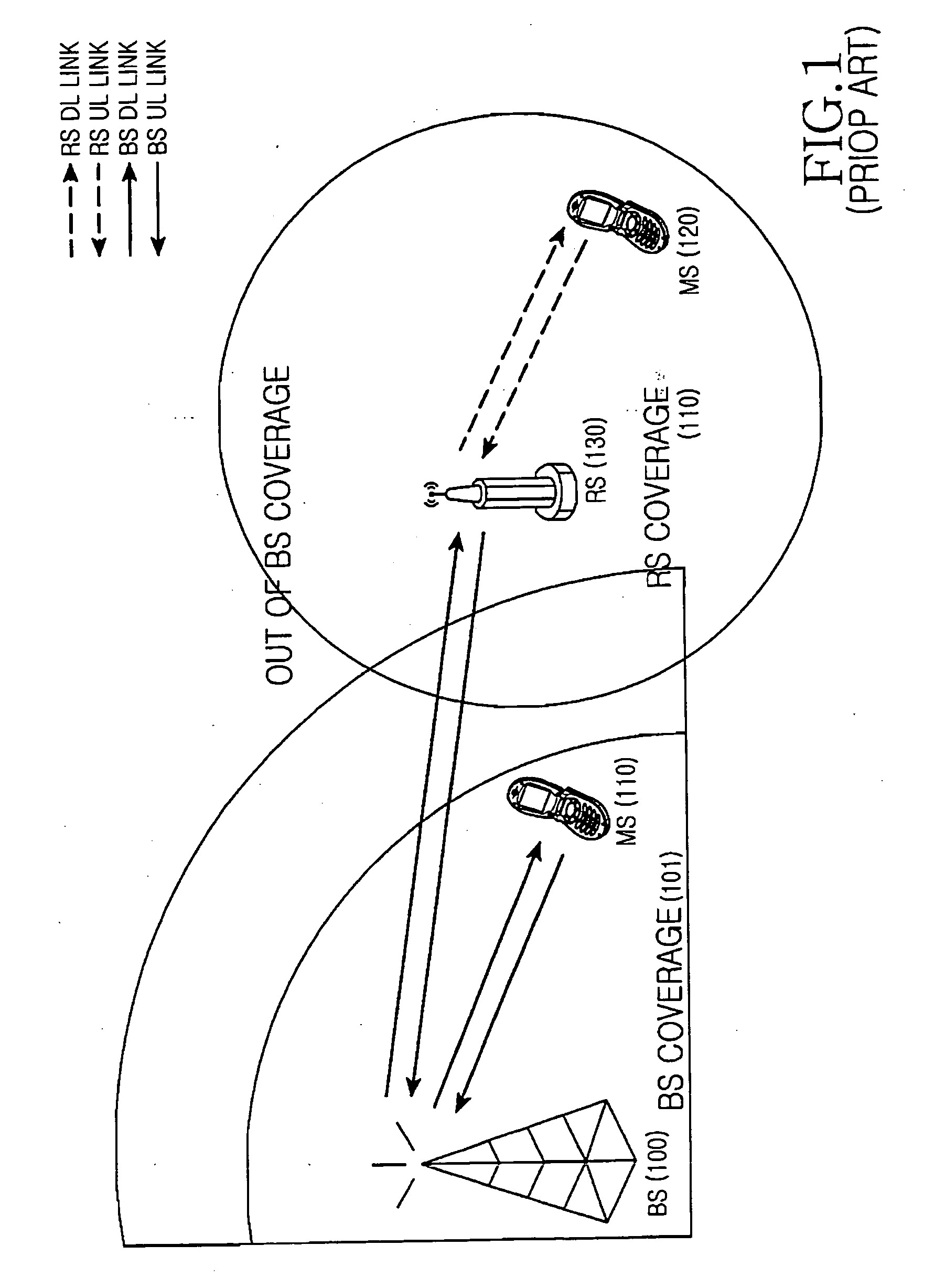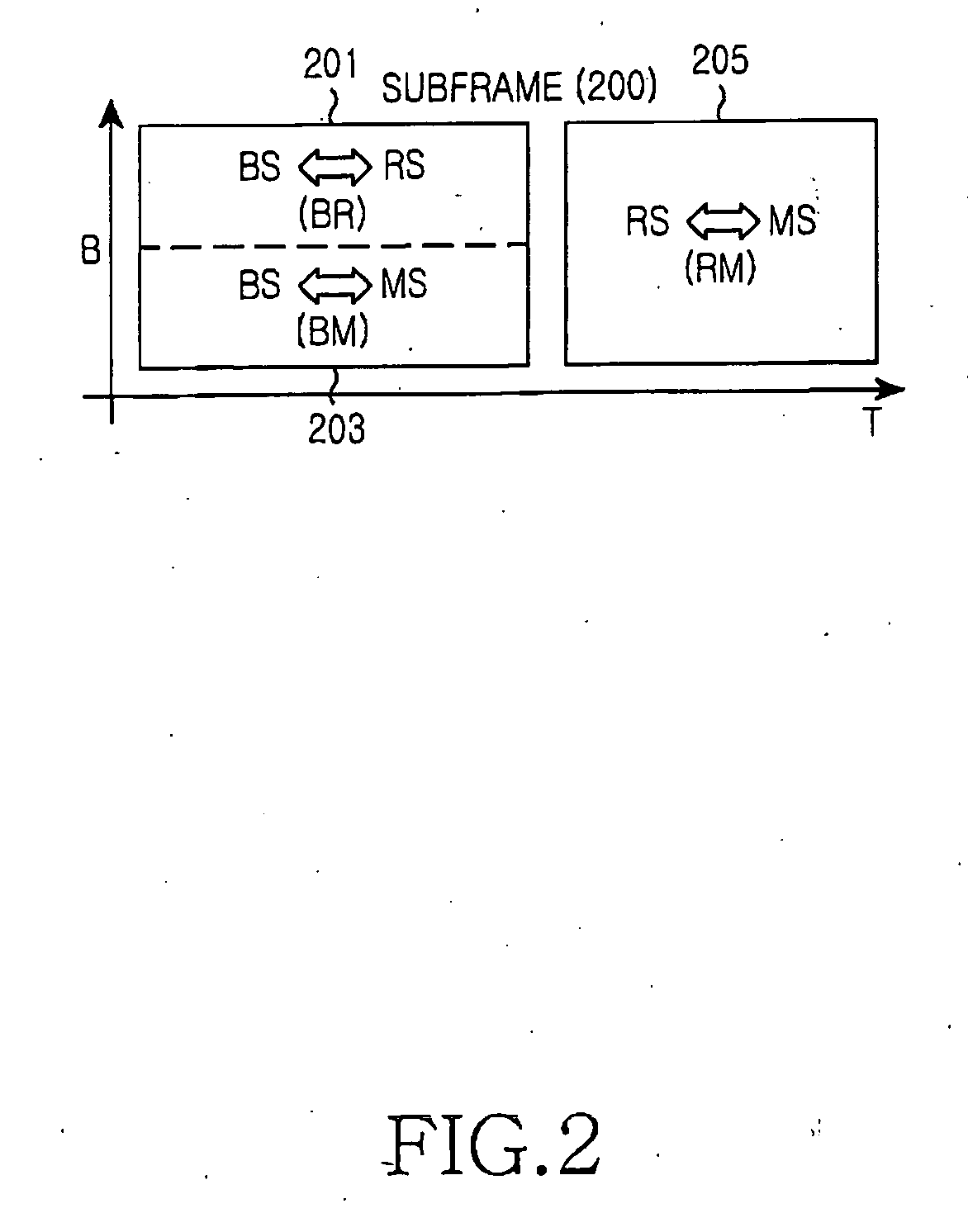Apparatus and method for constructing a frame to support multilink in multi-hop relay cellular network
- Summary
- Abstract
- Description
- Claims
- Application Information
AI Technical Summary
Benefits of technology
Problems solved by technology
Method used
Image
Examples
first embodiment
[0045]FIG. 2 illustrates a subframe structure for a multi-hop relay cellular network according to the present invention.
[0046] Referring to FIG. 2, a subframe 200 includes a first section for communication with a BS by a direct link and a second section for communication with the BS by a relay link. The first and second sections are separated by a time slot such that each of the BS, an RS, and an MS can be controlled to receive a signal only in its time section. The first and second sections can be arranged in a reversed order.
[0047] The first section for direct communication with the BS is divided into a BS-RS subframe 201 and a BS-MS subframe 203. The BS-RS subframe 201 and the BS-MS subframe 203 are separately located in the single section (the first section) of the subframe 200 by a subframe-in-subframe scheme and have different bursts. That is, the BS generates the subframe 200 by regarding the RS as an MS.
[0048] Here, the subframes 201 and 203 can be assigned for the bursts ...
second embodiment
[0053]FIG. 3 illustrates a subframe structure for a multi-hop relay cellular network according to the present invention.
[0054] Referring to FIG. 3, a subframe 300 includes a first section for communication with an MS and a second section for communication between a BS and an RS. The first and second sections are separated by a time resource. Further, the first and second sections are separated by a subframe-by-subframe scheme and can be arranged in a reversed order.
[0055] The first section for communication with the MS is divided into an RS-MS subframe 301 and a BS-MS subframe 303. The RS-MS subframe 301 and the BS-MS subframe 303 are separately located in the single section (the first section) of the subframe 300 by a subframe-in-subframe scheme and have different bursts. Since the BS and a plurality of RSs perform transmission using the subframes (the RS-MS subframe 301 and the BS-MS subframe 303) of the first section, a permutation including a dedicated pilot can be used for eac...
third embodiment
[0057]FIG. 4 illustrates a subframe structure for a multi-hop relay cellular network according to the present invention.
[0058] Referring to FIG. 4, a subframe 400 includes a first section and a second section. The first section includes a BS-RS subframe 401 and a BS-MS subframe 403, and the second section includes an RS-MS subframe 405 and a BS-MS subframe 407. The BS-RS subframe 401 and the RS-MS subframe 405 are arranged by a subframe-by-subframe scheme, and the BS-MS subframes 403 and 407 are respectively arranged in the first and second sections by a frame-by-frame scheme. The first and second sections are separated using a time resource and can be arranged in a reversed order.
[0059] The first section for direct communication with the BS is divided into the BS-RS subframe 401 and the BS-MS subframe 403. The BS-RS subframe 401 and the BS-MS subframe 403 are separately located in the single section (the first section) of the subframe 400 by a subframe-in-subframe scheme and have ...
PUM
 Login to View More
Login to View More Abstract
Description
Claims
Application Information
 Login to View More
Login to View More - R&D
- Intellectual Property
- Life Sciences
- Materials
- Tech Scout
- Unparalleled Data Quality
- Higher Quality Content
- 60% Fewer Hallucinations
Browse by: Latest US Patents, China's latest patents, Technical Efficacy Thesaurus, Application Domain, Technology Topic, Popular Technical Reports.
© 2025 PatSnap. All rights reserved.Legal|Privacy policy|Modern Slavery Act Transparency Statement|Sitemap|About US| Contact US: help@patsnap.com



